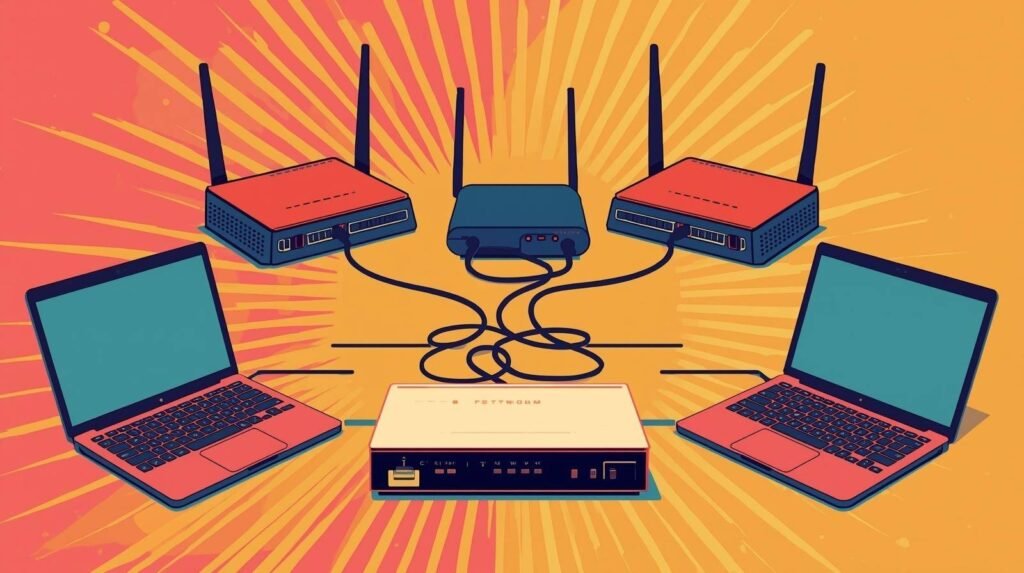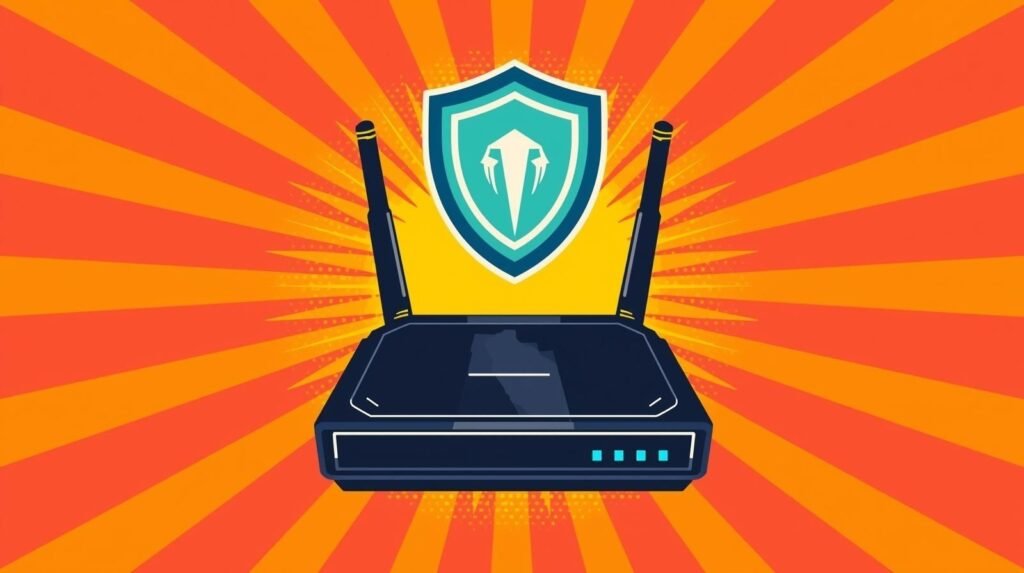How I Built My Home Cybersecurity Lab (Step-by-Step) 🔧
How I Built My Home Cybersecurity Lab (Step-by-Step) 🔧: Part 1/3
A home cybersecurity lab (sometimes called a home ethical hacking lab) is the safest way to practice hacking skills without putting your personal network at risk. Instead of experimenting on your daily devices, you isolate everything into a controlled environment.
This post shows you how to build a home cybersecurity lab that is budget-friendly, realistic, and future-proof.
This is Post 1 in my Home Lab Series. Later posts will go deeper into:
- Configuring my Cudy WR3000 VPN router as a ProtonVPN router (WireGuard, killswitch, per-device policies). The best router for ethical hacking lab that don’t cost a lot.
- How to set up a TP-Link router for lab, a dedicated victim router and a Windows 10 victim machine.
- Running my first safe pentest (Kali Linux → Windows 10).
- Using a Wi-Fi adapter with monitor mode for wireless pentesting in attacker devices.
Coming soon
👉 “How to build a home cybersecurity lab with a setup that’s budget-friendly, realistic, and future-proof.”
Key Takeaways
- 🔐 How to build a home cybersecurity lab? The setup lets you practice without risking your main network.
- 💻 You only need a few budget components: a VPN router, a TP-Link victim router, and an old laptop.
- ⚡ Windows 10 is more realistic than Windows 7 — it reflects real-world targets better.
- 🔧 Simple upgrades like a 225 GB SSD and 4 GB RAM make old laptops excellent victims.
- 🚀 This is a cheap cybersecurity lab setup under $150 that you can expand later.
👉 Want everything bundled with screenshots, configs, troubleshooting, and advanced topics (multi-VPN, VLANs, IDS/IPS)? Subscribe to my newsletter — I’ll send you the full Home Cybersecurity & Ethical Hacking Lab eBook (coming soon) for free when it’s ready.
“The best way to learn cybersecurity is by building your own lab where mistakes don’t matter.”
“Cybercriminals may target freelancers due to the potential for a lack of security on their devices and less corporate support for adhering to best practices to safeguard themselves from hackers and threats.”
I personally admire Sir Stephen Fry — I enjoy listening to his thoughtful views, and I’m often inspired by how he looks at technology and society.


Why a Home Cybersecurity (Ethical Hacking) Lab Matters🧠
Why go through the effort of building a home cybersecurity lab? Because it gives you something no online course can: hands-on practice in a safe, realistic environment. Think of it as your home ethical hackers lab — a realistic but isolated environment where breaking things is part of the process.
This lab is your own cybersecurity playground. Some call it a home ethical hacking lab, others an ethical hacking lab setup. I call it freedom to break, fix, and learn without consequences.
- 1. Practice without risk 🛡️Running scans or exploits on your home network can break things — trust me, I once knocked my smart TV offline for a day just by testing a simple nmap scan. In a lab, mistakes are part of the process, and nothing important is at stake.
- 2. Realistic environment 💻It’s tempting to only use VMs, but real attackers don’t limit themselves to clean virtual machines. A dedicated victim laptop with Windows 10 (unpatched) is far closer to what exists in the wild. This makes your tests and exploits feel authentic, not staged.
- 3. Learn networking 🌐Reading about subnets and routing is one thing — configuring them yourself is another. By splitting your home lab into multiple subnets (home, attack, victim), you see how data flows, how VPN tunnels behave, and how firewalls enforce isolation. This practical knowledge sticks far better than theory.
In short: this lab is your own cybersecurity playground. Some call it a home ethical hacking lab, others an ethical hacking lab setup. I call it freedom to break, fix, and learn without consequences.


What You Need to Build a Home Cybersecurity Lab (budget-friendly) 🧰
Here’s the exact gear I used. You don’t need high-end equipment — I chose affordable, available devices that get the job done.
- ISP modem/router (your provider’s default box, any brand works worldwide)
- Attack Router: Cudy router WR3000 AX3000 Wi-Fi 6 Router
- Victim Router: TP-Link Archer AX18 (AX1500 Wi-Fi 6 Router)
- Host laptop: used daily, connected to the ISP router (Proximus in my case)
- Attack Machine: My daily laptop running a Kali Linux VM for beginners (with ProtonVPN WireGuard dock buttons/scripts)
- Victim Machine: One old laptop with Windows 10 (fresh install, no updates, valid license key required)
💡 Tip: Old laptops often come with slow hard drives (HDD) and little RAM. If you want smoother performance, consider a cheap upgrade: replacing the HDD with an SSD and adding extra RAM. I did this myself and it made the victim machine much more responsive, without changing the realism of the lab setup.
⚠️ Note: Some people suggest dual-booting Windows 7 as a victim OS or even installing Metasploit as a separate system. In reality, Windows 7 is outdated and too easy to exploit, which makes it less useful for practice. Windows 10 is much more realistic. Metasploit itself runs inside Kali Linux, not as a separate OS.
Extras:
A few Ethernet cables — make sure at least one is long enough to reach from your main router to your lab setup. I personally needed a 5‑meter cable, which was inexpensive but essential.
USB sticks for recovery images and configs
Windows 10 license key (if you don’t have a licence key, send me an email, don’t buy it on Amazon, much to expensive there).
Wi-Fi Network Adapter with Monitor Mode — essential for wireless pentesting. I’ll cover this in detail in a later post.
💡 A VPN router is essential for a home cybersecurity lab if you want both anonymity and control.
Previous Posts
How to Set Up ProtonVPN WireGuard on Kali Linux (Part 1) — Clean install & config (wg-quick, keys, DNS) → Read now
ProtonVPN Killswitch on Kali (Part 2) — Prevent leaks with iptables/nftables → Read more
One‑Click Automation in Kali (Part 3) — Dock buttons & scripts for instant connect/disconnect → Read how
Network Topology for a Pentesting Lab at Home 🗺️
[ ISP Modem / Gateway ] 192.168.1.1
|-- LAN1 → [ Cudy WR3000 VPN Router ] 192.168.10.1
| |-- Kali Linux VM (192.168.10.100)
| |-- Attack Laptop (192.168.10.101)
|
|-- LAN2 → [ TP-Link AX18 Victim Router ] 192.168.20.1
| |-- Victim Windows 10 (192.168.20.50)
|
|-- LAN3 → Normal home devices (phones, TV, work laptop)Why split it like this? 🤔
- Attack subnet (Cudy WR3000 VPN router): All traffic goes through ProtonVPN → internet. Built-in killswitch ensures no leaks.
- Victim subnet (TP-Link victim router): Machines stay local but separate, simulating vulnerable clients.
- Home subnet (ISP modem): Normal devices stay untouched and safe.


Why Use a VPN Router for Cybersecurity 🛡️
- Central killswitch: If the VPN drops, no traffic leaks from the attack subnet.
- Per-device control: Decide which clients must go through the VPN (and which don’t).
- Privacy: Your testing traffic shows ProtonVPN’s IP, not your home IP.
- Flexibility: Victims remain reachable locally, lab stays isolated.
“A VPN router is essential for a home cybersecurity lab if you want both anonymity and control.”
Multi-VPN Option (Advanced) 🔁
For extra privacy, I also tested running a second VPN inside Kali Linux. This creates a VPN-over-VPN setup: in my pentesting lab at home, this gave me more flexibility.
Make sure to explore all the necessary components. Configurate to maximize your learning experience.
Router VPN = ProtonVPN (Belgium, WireGuard)
Kali VPN = ProtonVPN (US, OpenVPN)
This adds latency but gives more anonymity and flexibility when
Step-by-Step Setup Recap 🧭
- 1. Buy the hardware (Cudy WR3000 VPN router, TP-Link victim router, Windows 10 license, cables, Wi-Fi adapter with monitor mode).
- 2. Connect Cudy WR3000 VPN router to ISP modem (WAN → LAN).
- 3. TP-Link victim router to ISP modem (WAN → LAN).
- 4. Assign subnets: 192.168.10.x for attack, 192.168.20.x for victims.
- 5. Set up Kali Linux VM with ProtonVPN dock buttons.
- 6. Install Windows 10 on victim laptop, disable updates.
- 7. Test connectivity and confirm VPN IP with DNS Leak Test (VPN router + victim router separation).
- 8. Prepare Wi-Fi adapter for later wireless pentesting (covered in an upcoming post).
Safety First ⚠️
⚠️ Only attack the devices you set up yourself. This home ethical hacking lab (or home ethical hackers lab) is 100% isolated from my normal home network. Always follow ethical hacking rules.


Frequently Asked Questions ❓
❓ Do I really need a VPN router for a home cybersecurity or ethical hacking lab?
No, you can use only VMs and NAT, but a VPN router adds isolation, killswitch support, and realism.
❓ Can I build a home ethical hacking lab without buying new hardware?
Partly, yes. You can run Kali Linux in a VM on your existing laptop. But for realism and safe segmentation, an extra router and a victim machine are strongly recommended.
❓ Why use Windows 10 instead of Windows 7 as a victim machine?
Windows 7 is outdated and too easy to exploit. Windows 10 is closer to real-world targets and better for practice.
❓ Is one victim machine enough?
Yes, to start. One old laptop with Windows 10 is fine. Later you can add more devices or VMs (Linux, IoT) as your lab grows. This is the essence of building an ethical hacking lab setup step by step. This simple ethical hacking lab setup is enough to start learning without expensive hardware.
❓ Which Wi-Fi adapter do you recommend for monitor mode?
Any adapter based on Atheros or Realtek chipsets usually works well with Kali Linux. I’ll go into detail in a future post dedicated to wireless pentesting.
❓ How much does it cost to build a home cybersecurity lab?
“With budget routers, an old laptop, and upgrades like SSD and RAM, you can build one for under $150.
❓ Can this lab replace professional training?
Not completely. But it’s a fantastic starting point to gain hands-on skills before you invest in courses or certifications.
❓ Is this setup safe for my home network?
Yes, as long as you keep your lab segmented. My ISP modem, Cudy WR3000 VPN router, and TP-Link victim router all run in separate subnets. That way, my normal home devices stay untouched.
❓ Can I use Windows 11 instead of Windows 10?
Yes, but it will be harder to exploit because Windows 11 is newer and more secure. If you want a realistic but slightly easier target, Windows 10 remains the best choice for now.
❓ How can I expand my lab later?
You can add Linux victim VMs, IoT devices, or even cloud components. Start small, then grow step by step as your skills increase. Even with one victim machine, Kali Linux in a VM remains the best attack platform for a pentesting lab at home. for a pentesting lab at home.
❓ Is it legal to run a home ethical hacking lab?
Yes, it is legal as long as you only attack devices you own and control
❓ Do I need a Wi-Fi 6 or Wi-Fi 6E router for my lab?
Not really. Any stable router will do for segmentation. Wi-Fi 6/6E offers faster speeds and more range, but it doesn’t change the security learning. Budget routers like the Cudy WR3000 or TP-Link AX18 already provide everything you need.
Coming up next
Part 2 — Configuring the Cudy WR3000 as a ProtonVPN WireGuard Router (Step-by-Step Guide)
In the next article, we’ll configure the Cudy WR3000 as a dedicated ProtonVPN WireGuard router. You’ll learn how to set up the firmware, apply ProtonVPN configuration files, and secure your lab network with a fast, reliable VPN router.
Part 3 — Full Privacy Online
Then we’ll switch gears to focus on full privacy online. From VPN hygiene to locale and browser tweaks, DNS/WebRTC leak fixes, and evidence sanitization — discover how to keep your lab activity as undetectable as possible.
Coming soon
Part 4 (The eBook)
Once the four-part series is complete, we’ll expand it into a comprehensive eBook. It will include extended case studies, additional scripts, and illustrated step-by-step screenshots — a complete manual you can use as both a reference guide and portfolio piece.


“Really interesting post! 👌 When can we expect the follow-up? I’m curious about the next steps.”
Thanks a lot! The follow-up is already planned and will be published soon. 🚀 I’m also working on a more detailed eBook that goes even deeper into this topic than my blog posts. It will be free for everyone who subscribes to my newsletter — that way you’ll also get notified when new articles go live.